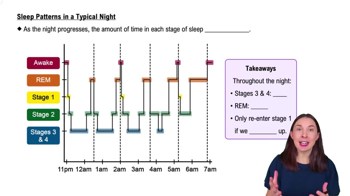Table of contents
- 1. Introduction to Psychology1h 43m
- 2. Psychology Research2h 20m
- 3. Biological Psychology2h 41m
- 4. Sensation and Perception28m
- 5. Consciousness and Sleep32m
- 6. Learning41m
- 7. Memory34m
- 8. Cognition37m
- 9. Emotion and Motivation35m
- 10. Developmental Psychology33m
- 11. Personality48m
- 12. Social Psychology41m
- 13. Stress and Health41m
- 14. Psychological Disorders44m
- 15. Treatment47m
5. Consciousness and Sleep
Sleep
Struggling with Psychology?
Join thousands of students who trust us to help them ace their exams!Watch the first videoMultiple Choice
The particular level of body weight that the body tries to maintain is known as the
A
metabolism.
B
weight set point.
C
basal metabolic rate.
D
body mass index.
 Verified step by step guidance
Verified step by step guidance1
Begin by understanding the concept of 'weight set point'. This is the theory that the body has a certain weight range that it naturally tries to maintain, which is regulated by biological mechanisms.
Next, consider the term 'metabolism'. Metabolism refers to the chemical processes that occur within a living organism in order to maintain life, including converting food to energy.
Examine 'basal metabolic rate'. This is the rate at which the body uses energy while at rest to maintain vital functions such as breathing and keeping warm.
Understand 'body mass index' (BMI). BMI is a measure of body fat based on height and weight that applies to adult men and women.
Finally, compare these concepts to determine which one aligns with the idea of the body maintaining a specific weight. The 'weight set point' is the concept that directly relates to the body's attempt to maintain a particular level of body weight.

 3:25m
3:25mWatch next
Master Circadian Rhythms with a bite sized video explanation from Hannah Gordils
Start learningRelated Videos
Related Practice


































































































![Race, Genes and IQ Differences | Bret Weinstein [Mini Clip]](https://img.youtube.com/vi/IztL_m3pd70/mqdefault.jpg)



































































































